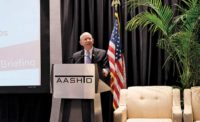Transportation officials are pleased that Congress is nearing approval of legislation to continue federal highway and transit programs for the next 12 months. But they are quick to add that the one-year extension, with only flat funding, is far from their goal of a well-funded long-term surface transportation measure.
As a new American Society of Civil Engineers report shows, if highway and transit funding remains constant, the gap between expenditures and surface transportation capital needs will only continue to climb.
The ASCE study, a preliminary report released on Sept. 23, focuses on highways and public transit. It is part of the group’s Failure to Act studies, which look at specific infrastructure sectors.
In a briefing on the report, author Steven Landau, executive vice president of economic research firm EBP US, said that highway infrastructure would need an additional $12 billion per year, or $238 billion over 20 years, to address the present backlog and anticipated future needs. That would equal a 29% increase over the two decades.
For transit and intercity rail, the capital backlog now is an estimated $176 billion. That will increase to $500 billion in 2039 if spending holds at current levels, Landau said. The capital backlog includes facilities and other infrastructure, but also buses and railcars. The widest gaps will be in the MidAtlantic and Great Lakes regions, he said.
Using a broader “needs” measurement, the ASCE report projects that the “total investment gap” for surface transportation will be about $2.1 trillion from 2020 through 2039. Of that total, the highway and bridge gap is $1.5 trillion and the transit and intercity rail shortfall is $535 billion.
Kristina Swallow, Nevada Dept. of Transportation Secretary, said during the briefing, “Even in a state with some of the best roads in the nation, our ability to keep up with the demands of preservation and new construction will increasingly be a challenge unless action is taken now to increase revenue.”
She noted that Nevada’s most populous counties already index motor-fuels taxes to account for inflation, which helps officials in their efforts to keep up with highway improvement work.
But she also pointed out that the federal gas tax hasn’t been increased in more than 20 years.
Ward McCarragher, American Public Transportation Association vice president for government affairs, said, "You can’t overstate the benefits of getting a one-year extension” He added, "That does allow some interim planning and it’s a whole world better than... 30- and 60-day extensions."
When some past authorization laws expired, transportation officials and engineering and construction firms that work on highway and transit projects had to endure many extensions lasting just weeks or months.
Carragher also said that the ASCE report illustrates the impact of not having a long-term bill with a boost in funding: "We don’t get increased investment. We will fall further behind."
He added, "We need to get a transformational authorization bill on the President’s desk at the outset of the new year.”
Ed Mortimer, U.S. Chamber of Commerce vice president for transportation and infrastructure, said, "We are glad that Congress was able to come together on a bipartisan basis on a one-year extension." He added, "That will allow…all the [state] DOTs to continue to know what their federal partners can provide for the next year."
But Mortimer made clear that a long-range transportation measure remains prime target for advocates like the U.S. Chamber.
"We need to get this done," he said. “From the business community’s perspective, the longer we wait, the more lost productivity we're going to have.”
The final ASCE report on surface transportation is expected later this year, a spokesperson said.



Post a comment to this article
Report Abusive Comment